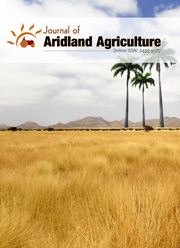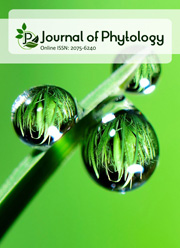Effect of heavy metals on phenylpropanoid biosynthesis in Euonymus alatus
DOI:
https://doi.org/10.25081/jaa.2023.v9.8699Keywords:
Euonymus alatus, Heavy metals, Phenolic compounds, CuCl2, HgCl2, NiSO4Abstract
The productivity of the phenylpropanoid biosynthesis pathway in plants varies depending on the type of stress. In this work, we looked into how different phenylpropanoid chemicals accumulated in Euonymus alatus following exposure to different concentrations of CuCl2 (0.1, 0.5, and 1 mM), HgCl2 (0.1, 0.5, and 1 mM), and NiSO4 (10, 50, and 100 mM). We analyzed some of the individual phenolic chemicals by high-performance liquid chromatography (HPLC). In nearly all cases, rutin showed the largest concentration among the phenylpropanoid chemicals, followed by epicatechin, sinapic acid, p-coumaric acid, trans-cinnamic acid, ferulic acid, and caffeic acid. However, due to the change in the concentration of the heavy metals, the amount of phenylpropanoid changed. The highest accumulation of phenylpropanoid was documented in 0.1 mM CuCl2, whereas it was reduced in 1 mM HgCl2 exposed plants. These findings unequivocally demonstrate that the phenylpropanoid metabolic pathway took part in the heavy metal tolerance process, which shielded E. alatus from the oxidative damage brought on by heavy metals. Thus, under a variety of environmental stress situations, this species with a high tolerance to heavy metals may survive.
Downloads
References
Biala, W., & Jasinski, M. (2018). The phenylpropanoid case - It is transport that matters. Frontiers in Plant Science, 9, 1610. https://doi.org/10.3389/fpls.2018.01610
Cevallos-Casals, B. A., & Cisneros-Zevallos, L. (2010). Impact of germination on phenolic content and antioxidant activity of 13 edible seed species. Food Chemistry, 119(4), 1485-1490. https://doi.org/10.1016/j.foodchem.2009.09.030
Chung, I. M., Kim, J. J., Lim, J. D., Yu, C. Y., Kim, S. H., & Hahn, S. J. (2006). Comparison of resveratrol, SOD activity, phenolic compounds and free amino acids in Rehmannia glutinosa under temperature and water stress. Environmental and Experimental Botany, 56(1), 44-53. https://doi.org/10.1016/j.envexpbot.2005.01.001
Clemens, S., & Weber, M. (2016). The essential role of coumarin secretion for Fe acquisition from alkaline soil. Plant Signaling & Behavior, 11(2), e1114197. https://doi.org/10.1080/15592324.2015.1114197
Demirezen, D., & Aksoy, A. (2006). Heavy metal levels in vegetables in Turkey are within safe limits for Cu, Zn, Ni and exceeded for Cd and Pb. Journal of Food Quality, 29(3), 252-265. https://doi.org/10.1111/j.1745-4557.2006.00072.x
Enogieru, A. B., Haylett, W., Hiss, D. C., Bardien, S., & Ekpo, O. E. (2018). Rutin as a potent antioxidant: Implications for neurodegenerative disorders. Oxidative Medicine and Cell Longevity, 2018, 6241017. https://doi.org/10.1155/2018/6241017
Fan, L., Zhang, C., Ai, L., Wang, L., Li, L., Fan, W., Li, R., He, L., Wu, C., & Huang, Y. (2020). Traditional uses, botany, phytochemistry, pharmacology, separation and analysis technologies of Euonymus alatus (Thunb.) Siebold: a comprehensive review. Journal of Ethnopharmacology, 259, 112942. https://doi.org/10.1016/j.jep.2020.112942
Grzesik, M., Naparlo, K., Bartosz, G., & Sadowska-Bartosz, I. (2018). Antioxidant properties of catechins: Comparison with other antioxidants. Food Chemistry, 241, 480-492. https://doi.org/10.1016/j.foodchem.2017.08.117
He, S.-Y., Qiu, X.-M., Wang, Y.-Q., Su, Z.-Q., Zhang, B.-Y., Wen, Z., Yang, Y.-F., Xing, B.-F., Hong, M., & Liao, R. (2022). Intervention effect of Potentilla discolor-Euonymus alatus on intestinal flora of type 2 diabetes mellitus rats. European Review for Medical and Pharmacological Science, 26(24), 9062-9071. https://doi.org/10.26355/eurrev_202212_30655
Kim, N. S., Sathasivam, R., Chun, S. W., Youn, W. B., Park, S. U., & Park, B. B. (2020). Biosynthesis of phenylpropanoids and their protective effect against heavy metals in nitrogen-fixing black locust (Robinia pseudoacacia). Tropical Journal of Pharmaceutical Research, 19(5), 1065-1072. https://doi.org/10.4314/tjpr.v19i5.23
Kisa, D., Elmastas, M., Ozturk, L., & Kayir, O. (2016). Responses of the phenolic compounds of Zea mays under heavy metal stress. Applied Biological Chemistry, 59, 813-820. https://doi.org/10.1007/s13765-016-0229-9
Kivaisi, A. K. (2001) The potential for constructed wetlands for wastewater treatment and reuse in developing countries: a review. Ecological Engineering, 16(4), 545-560. https://doi.org/10.1016/S0925-8574(00)00113-0
Korkina, L., Kostyuk, V., De Luca, C. & Pastore, S. (2011). Plant phenylpropanoids as emerging anti-inflammatory agents. Mini-Reviews in Medicinal Chemistry, 11(10), 823-835. https://doi.org/10.2174/138955711796575489
Lombardi, L., & Sebastiani, L. (2005). Copper toxicity in Prunus cerasifera: growth and antioxidant enzymes responses of in vitro grown plants. Plant Science, 168(3), 797-802. https://doi.org/10.1016/j.plantsci.2004.10.012
Madera-Parra, C. A., Pena-Salamanca, E. J., Pena, M. R., Rousseau, D. P. L., & Lens, P. N. L. (2015). Phytoremediation of Landfill Leachate with Colocasia esculenta, Gynerum sagittatum and Heliconia psittacorum in Constructed Wetlands. International Journal of Phytoremediation, 17(1), 16-24. https://doi.org/10.1080/15226514.2013.828014
Mehra, P., Garg, M., Koul, A., & Bansal, D. D. (2013). Effect of (+)-catechin hydrate on oxidative stress induced by high sucrose and high fat diet in male Wistar rats. Indian Journal of Experimental Biology, 51(10), 823-827.
Ning, K., Zhou, T., Wang, Y., El-Kassaby, Y. A., & Ma, Y. (2022). The complete chloroplast genome of Euonymus alatus (Celastraceae). Mitochondrial DNA Part B Resources, 7(4), 707-708. https://doi.org/10.1080/23802359.2022.2067494
Panda, P., Appalashetti, M., & Judeh, Z. M. A. (2011). Phenylpropanoid sucrose esters: Plant-derived natural products as potential leads for new therapeutics. Current Medicinal Chemistry, 18(21), 3234-3251. https://doi.org/10.2174/092986711796391589
Qin, X. Y., Yan, S. X., & Wei, F. Y. (2011). Geographical distribution of plants of Celastraceae in China. Journal of Northeast Forestry University, 39(1), 120-123.
Shen, Y. B., Song, X., Li, L., Sun, J., Jaiswal, Y., Huang, J. Q., Liu, C., Yang, W. J., Williams, L., Zhang, H., & Guan, Y. (2019). Protective effects of p-coumaric acid against oxidant and hyperlipidemia-an in vitro and in vivo evaluation. Biomedicine and Pharmacotherapy, 111, 579-587. https://doi.org/10.1016/j.biopha.2018.12.074
Xu, D., Hu, M.-J., Wang, Y.-Q., & Cui, Y.-L. (2019). Antioxidant activities of quercetin and its complexes for medicinal application. Molecules, 24(6), 1123. https://doi.org/10.3390/molecules24061123
Yang, C. S., Landau, J. M., Huang, M.-T., & Newmark, H. L. (2001). Inhibition of carcinogenesis by dietary polyphenolic compounds. Annual Review of Nutrition, 21, 381-406. https://doi.org/10.1146/annurev.nutr.21.1.381
Yao, L. H., Jiang, Y. M., Shi, J., Tomas-Barberan, F. A., Datta, N., Singanusong, R., & Chen, S. S. (2004). Flavonoids in food and their health benefits. Plant Foods for Human Nutrition, 59, 113-122. https://doi.org/10.1007/s11130-004-0049-7
Zhai, X., Lenon, G. B., Xue, C. C. L., & Li, C.-G. (2016). Euonymus alatus: A review on its phytochemistry and antidiabetic activity. Evidence Based Complementary and Alternative Medicine, 2016, 9425714. https://doi.org/10.1155/2016/9425714
Zhao, J., Davis, L. C., & Verpoorte, R. (2005). Elicitor signal transduction leading to production of plant secondary metabolites. Biotechnology Advances, 23(4), 283-333. https://doi.org/10.1016/j.biotechadv.2005.01.003
Published
How to Cite
Issue
Section
Copyright (c) 2023 Ramaraj Sathasivam, Haeng-Hoon Kim, Bao Van Nguyen, Jiwon Yoon, Byung Bae Park, Jae Kwang Kim, Sang Un Park

This work is licensed under a Creative Commons Attribution-NonCommercial 3.0 Unported License.





 .
.